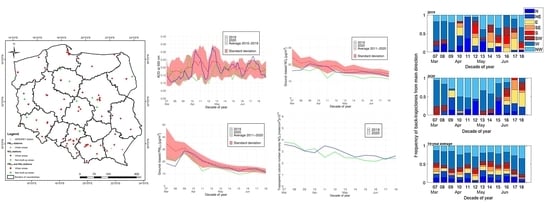Reduction of Air Pollution in Poland in Spring 2020 during the Lockdown Caused by the COVID-19 Pandemic
Abstract
:1. Introduction
2. Materials and Methods
2.1. Description of the Datasets Analyzed
2.1.1. Study Area
2.1.2. In-Situ Air Quality Measurements
2.1.3. Tropospheric NO2 Column Density (NO2 TVCD) Retrieved from Sentinel-5P TROPOMI Measurements
- Tropospheric and stratospheric columns are separated;
- Tropospheric and stratospheric slant columns are converted into tropospheric vertical column density and stratospheric vertical column density.
2.1.4. Ancillary Data from Models and Radiosondes
- NOAA Hybrid Single-Particle Lagrangian Integrated Trajectory (HYSPLIT) model [30] to estimate transport of air masses. This included 96 trajectories for Warsaw at 0.5 km based on the Global Land Data Assimilation System GLDAS meteorological data at 1° × 1° spatial resolution.
- The World Meteorological Organisation (WMO) radiosonde measurements for temperature profiles from the Legionowo weather station 20 km from Warsaw to identify surface air temperature inversions.
2.2. Methods of Data Processing
2.2.1. Analysis of In-Situ PM2.5 and NO2 Measurements
- 10-year decadal averages and standard deviations (2011–2020) for each decade from 7 to 18 for all analysed cases (except for the PM2.5 estimates for non-built-up areas which featured a shorter time series);
- 8-year decadal averages and standard deviations (2013–2020) for each decade from 7 to 18 for PM2.5 decadal estimates for non-built-up areas;
- annual averages from the 7 to 18 decade (March–June), which were further used to derive linear temporal trends. If a temporal trend was statistically significant according to a t-test [31], it was used to derive annual anomalies of PM2.5 and NO2 concentrations. On the contrary, if the temporal trend was statistically insignificant, then a multi-annual average was used to compute annual anomalies.
2.2.2. Analysis of the Sentinel-5 Tropospheric NO2 Column Density
- decadal median NO2 for Poland;
- decadal median NO2 for urban areas in Poland where GIOS air quality stations are located;
- decadal median NO2 for non-built-up areas in Poland where GIOS air quality stations are located;
- decadal median NO2 from S-5P pixels located within Warsaw administrative borders.
2.2.3. Analysis of Aerosol Optical Properties
3. Results and Discussion
3.1. Meteorological Conditions in Poland during Spring 2020
3.2. Background Aerosol Concentration in Poland
3.3. Decadal Variability in Ground-Based PM2.5 Concentration Measurements
3.4. Multi-Annual Variability of Ground-Based PM2.5 Concentration Measurements
3.5. Decadal Variability of Ground-Based NO2 Concentration Measurements
3.6. Multi-Annual Variability of Ground-Based NO2 Concentration Measurements
3.7. Decadal Variability of Tropospheric NO2 Column Number Density Derived from Sentinel-5P Satellite Data
4. Discussion
5. Conclusions
- Results revealed that PM2.5 and NO2 atmospheric concentrations and AOD decreased significantly in spring 2020 in comparison with 2019 and 2011–2020 average concentrations. Overall, air quality in Poland improved during COVID-19 lockdown in spring 2020.
- The period of the strictest restrictions (11–20th April) was the least polluted.
- According to aerosol optical properties observed at the background station at Strzyzow, the mesoscale conditions, such as wind characteristics, in particular affected aerosol properties.
- NO2 concentrations were not affected by advection of air masses. They were affected by reduced transport and lower emissions from heating systems caused by the positive air temperature anomalies. Particularly, reductions in vehicle traffic in Warsaw corresponds well with the decrease in NO2 surface concentrations.
- Reduction of PM2.5, NO2 and NO2 TVCD over Poland during COVID-19 lockdown is low in comparison with reductions over other countries and cities.
- The novel data source originating from the Sentinel-5P satellite provides a unique perspective on NO2 surface concentrations, which corresponds well with in-situ air quality measurements.
Author Contributions
Funding
Institutional Review Board Statement
Informed Consent Statement
Data Availability Statement
Acknowledgments
Conflicts of Interest
References
- National Health Fund. Reasons of the Increase Number of Deaths in Poland in 2017. Available online: https://zdrowedane.nfz.gov.pl/course/view.php?id=10 (accessed on 5 November 2020). (In Polish)
- Sroczyński, J. The Impact of Atmos. Air Pollution on Human Health; PAN: Wrocław, Poland, 1988. (In Polish) [Google Scholar]
- European Environment Agency. Air Quality in Europe—2016 Report. Report No 28/2016. Available online: https://www.eea.europa.eu/publications/air-quality-in-europe-2016 (accessed on 3 December 2020).
- World Health Organisation. Coronavirus Disease (COVID-19) Situational Report 51. Available online: https://www.who.int/docs/default-source/coronaviruse/situation-reports/20200311-sitrep-51-covid-19.pdf?sfvrsn=1ba62e57_10 (accessed on 16 March 2020).
- Merriam-Webster.com. Lockdown. Available online: https://www.merrian-webster.com/dictionary/lockdown (accessed on 27 February 2021).
- Council of Ministers. Available online: https://monitorpolski.gov.pl/MP (accessed on 11 March 2021).
- Bauwens, M.; Compernolle, S.; Stavrakou, T.; Müller, J.; Van Gent, J.; Eskes, H.; Levelt, P.F.; van der A, R.; Veefkind, J.P.; Vlietinck, J.; et al. Impact of Coronavirus Outbreak on NO2 Pollution Assessed Using TROPOMI and OMI Observations. Geophys. Res. Lett. 2020, 47. [Google Scholar] [CrossRef]
- National Aeronautics and Space Administration. Airborne Nitrogen Dioxide Plummets over China. Available online: https://earthobservatory.nasa.gov/images/146362/airborne-nitrogen-dioxide-plummets-over-china (accessed on 15 December 2020).
- Dutheil, F.; Baker, J.S.; Navel, V. COVID-19 as a factor influencing air pollution? Environ. Pollut. 2020, 263, 114466. [Google Scholar] [CrossRef]
- Fu, F.; Purvis-Roberts, K.; Williams, B. Impact of the COVID-19 Pandemic Lockdown on Air Pollution in 20 Major Cities around the World. Atmosphere 2020, 11, 1189. [Google Scholar] [CrossRef]
- Venter, Z.S.; Aunan, K.; Chowdhury, S.; Lelieveld, J. COVID-19 lockdowns cause global air pollution declines. Proc. Natl. Acad. Sci. USA 2020, 117, 18984–18990. [Google Scholar] [CrossRef]
- Menut, L.; Bessagnet, B.; Siour, G.; Mailler, S.; Pennel, R.; Cholakian, A. Impact of lockdown measures to combat Covid-19 on air quality over western Europe. Sci. Total Environ. 2020, 741, 140426. [Google Scholar] [CrossRef]
- Filonchyk, M.; Hurynovich, V.; Yan, H. Impact of Covid-19 lockdown on air quality in the Poland, Eastern Europe. Environ. Res. 2020, 198, 110454. [Google Scholar] [CrossRef]
- Chief Inspectorate of Environmental Protection. Available online: http://www.gios.gov.pl/pl (accessed on 20 December 2020).
- Holben, B.; Eck, T.; Slutsker, I.; Tanré, D.; Buis, J.; Setzer, A.; Vermote, E.; Reagan, J.; Kaufman, Y.; Nakajima, T.; et al. AERONET—A Federated Instrument Network and Data Archive for Aerosol Characterization. Remote Sens. Environ. 1998, 66, 1–16. [Google Scholar] [CrossRef]
- Barreto, A.; Cuevas, E.; Granados-Muñoz, M.-J.; Alados-Arboledas, L.; Romero, P.M.; Gröbner, J.; Kouremeti, N.; Almansa, A.F.; Stone, T.; Toledano, C.; et al. The new sun-sky-lunar Cimel CE318-T multiband photometer—A comprehensive performance evaluation. Atmos. Meas. Tech. 2016, 9, 631–654. [Google Scholar] [CrossRef] [Green Version]
- Müller, T.; Laborde, M.; Kassell, G.; Wiedensohler, A. Design and performance of a three-wavelength LED-based total scatter and backscatter integrating nephelometer. Atmos. Meas. Tech. 2011, 4, 1291–1303. [Google Scholar] [CrossRef] [Green Version]
- Saturno, J.; Pöhlker, C.; Massabò, D.; Brito, J.; Carbone, S.; Cheng, Y.; Chi, X.; Ditas, F.; de Angelis, I.H.; Morán-Zuloaga, D.; et al. Comparison of different Aethalometer correction schemes and a reference multi-wavelength absorption technique for ambient aerosol data. Atmos. Meas. Tech. 2017, 10, 2837–2850. [Google Scholar] [CrossRef] [Green Version]
- Veefkind, J.; Aben, I.; McMullan, K.; Förster, H.; de Vries, J.; Otter, G.; Claas, J.; Eskes, H.; de Haan, J.; Kleipool, Q.; et al. TROPOMI on the ESA Sentinel-5 Precursor: A GMES mission for global observations of the Atmos. composition for climate, air quality and ozone layer applications. Remote Sens. Environ. 2012, 120, 70–83. [Google Scholar] [CrossRef]
- Gorelick, N.; Hancher, M.; Dixon, M.; Ilyushchenko, S.; Thau, D.; Moore, R. Google Earth Engine: Planetary-scale geospatial analysis for everyone. Remote Sens. Environ. 2017, 202, 18–27. [Google Scholar] [CrossRef]
- Boersma, K.F.; Eskes, H.J.; Veefkind, J.P.; Brinksma, E.J.; van der A, R.; Sneep, M.; Oord, G.H.J.V.D.; Levelt, P.F.; Stammes, P.; Gleason, J.F.; et al. Near-real time retrieval of tropospheric NO2 from OMI. Atmos. Chem. Phys. Discuss. 2007, 7, 2103–2118. [Google Scholar] [CrossRef] [Green Version]
- Boersma, K.F.; Eskes, H.J.; Dirksen, R.J.; van der A, R.; Veefkind, J.P.; Stammes, P.; Huijnen, V.; Kleipool, Q.L.; Sneep, M.; Claas, J.; et al. An improved tropospheric NO2 column retrieval algorithm for the Ozone Monitoring Instrument. Atmos. Meas. Tech. 2011, 4, 1905–1928. [Google Scholar] [CrossRef] [Green Version]
- Boersma, K.F.; Eskes, H.J.; Richter, A.; De Smedt, I.; Lorente, A.; Beirle, S.; van Geffen, J.H.G.M.; Zara, M.; Peters, E.; Van Roozendael, M.; et al. Improving algorithms and uncertainty estimates for satellite NO2 retrievals: Results from the quality assurance for the essential climate variables (QA4ECV) project. Atmos. Meas. Tech. 2018, 11, 6651–6678. [Google Scholar] [CrossRef] [Green Version]
- Van Geffen, J.H.G.M.; Boersma, K.F.; Van Roozendael, M.; Hendrick, F.; Mahieu, E.; De Smedt, I.; Sneep, M.; Veefkind, J.P. Improved spectral fitting of nitrogen dioxide from OMI in the 405–465 nm window. Atmos. Meas. Tech. 2015, 8, 1685–1699. [Google Scholar] [CrossRef] [Green Version]
- Williams, J.E.; Boersma, K.F.; Le Sager, P.; Verstraeten, W.W. The high-resolution version of TM5-MP for optimized satellite retrievals: Description and validation. Geosci. Model. Dev. 2017, 10, 721–750. [Google Scholar] [CrossRef] [Green Version]
- Loyola, D.; Lutz, R.; Argyrouli, A.; Spurr, R. S5P/TROPOMI ATBD Cloud Products. German Aerospace Center 2020. Available online: https://sentinel.esa.int/documents/247904/2476257/Sentinel-5P-TROPOMI-ATBD-Clouds (accessed on 3 February 2021).
- Gelaro, R.; McCarty, W.; Suárez, M.J.; Todling, R.; Molod, A.; Takacs, L.; Randles, C.; Darmenov, A.; Bosilovich, M.G.; Reichle, R.; et al. The Modern-Era Retrospective Analysis for Research and Applications, Version 2 (MERRA-2). J. Clim. 2017, 30, 5419–5454. [Google Scholar] [CrossRef]
- Randles, C.; Da Silva, A.M.; Buchard, V.; Colarco, P.R.; Darmenov, A.; Govindaraju, R.; Smirnov, A.; Holben, B.; Ferrare, R.; Hair, J.; et al. The MERRA-2 Aerosol Reanalysis, 1980 Onward. Part I: System Description and Data Assimilation Evaluation. J. Clim. 2017, 30, 6823–6850. [Google Scholar] [CrossRef]
- Levy, R.C.; Remer, L.A.; Dubovik, O. Global aerosol optical properties and application to Moderate Resolution Imaging Spectroradiometer aerosol retrieval over land. J. Geophys. Res. Space Phys. 2007, 112, D13210. [Google Scholar] [CrossRef] [Green Version]
- Stein, A.F.; Draxler, R.R.; Rolph, G.D.; Stunder, B.J.B.; Cohen, M.; Ngan, F. NOAA’s HYSPLIT Atmos. Transport and Dispersion Modeling System. Bull. Am. Meteorol. Soc. 2015, 96, 2059–2077. [Google Scholar] [CrossRef]
- Goulden, C.H. Methods of Statistical Analysis, 2nd ed.; Wiley and Sons: New York, NY, USA, 1956; pp. 50–55. [Google Scholar]
- Van Geffen, J.; Eskes, H.J.; Boersma, K.F.; Maasakkers, J.D.; Veefkind, J.P. TROPOMI ATBD of the Total and Tropospheric NO2 Data Products. Royal Netherlands Meteorological Institute, 1.4. Available online: https://sentinel.esa.int/documents/247904/2476257/Sentinel-5P-TROPOMI-ATBD-NO2-data-products (accessed on 20 January 2021).
- Compernolle, S.; Verhoelst, T.; Pinardi, G.; Granville, J.; Hubert, D.; Keppens, A.; Niemeijer, S.; Rino, B.; Bais, A.; Beirle, S.; et al. Validation of Aura-OMI QA4ECV NO2 climate data records with ground-based DOAS networks: The role of measurement and comparison uncertainties. Atmos. Chem. Phys. Discuss. 2020, 20, 8017–8045. [Google Scholar] [CrossRef]
- Zawadzka, O.; Markowicz, K.; Pietruczuk, A.; Zielinski, T.; Jaroslawski, J. Impact of urban pollution emitted in Warsaw on aerosol properties. Atmos. Environ. 2012, 69, 15–28. [Google Scholar] [CrossRef]
- Markowicz, K.M.; Zawadzka, O.; Posyniak, M.; Uscka-Kowalkowska, J. Long-Term Variability of Aerosol Optical Depth in the Tatra Mountain Region of Central Europe. J. Geophys. Res. Atmos. 2019, 124, 3464–3475. [Google Scholar] [CrossRef]
- Szczepanik, D.; Markowicz, K. The relation between columnar and surface aerosol optical properties in a background environment. Atmos. Pollut. Res. 2018, 9, 246–256. [Google Scholar] [CrossRef]
- Van Donkelaar, A.; Martin, R.; Park, R. Estimating ground-level PM2.5 using aerosol optical depth determined from satellite remote sensing. J. Geophys. Res. Space Phys. 2006, 111. [Google Scholar] [CrossRef]
- Liu, Y.; Paciorek, C.; Koutrakis, P. Estimating Regional Spatial and Temporal Variability of PM2.5 Concentrations Using Satellite Data, Meteorology, and Land Use Information. Environ. Health Perspect. 2009, 117, 886–892. [Google Scholar] [CrossRef] [Green Version]
- Xie, Y.; Wang, Y.; Zhang, K.; Dong, W.; Lv, B.; Bai, Y. Daily Estimation of Ground-Level PM2.5 Concentrations over Beijing Using 3 km Resolution MODIS AOD. Environ. Sci. Technol. 2015, 49, 12280–12288. [Google Scholar] [CrossRef] [Green Version]
- Guo, J.; Xia, F.; Zhang, Y.; Liu, H.; Li, J.; Lou, M.; He, J.; Yan, Y.; Wang, F.; Min, M.; et al. Impact of diurnal variability and meteorological factors on the PM2.5—AOD Relationship: Implications for PM2.5 Remote Sensing. Environ. Pollut. 2017, 221, 94–104. [Google Scholar] [CrossRef] [PubMed] [Green Version]
- Warsaw Municipal Roads Management. Little Traffic on the Roads. Available online: https://zdm.waw.pl/aktualnosci/maly-ruch-na-drogach/ (accessed on 2 March 2021). (In Polish).
- Piccoli, A.; Agresti, V.; Balzarini, A.; Bedogni, M.; Bonanno, R.; Collino, E.; Colzi, F.; Lacavalla, M.; Lanzani, G.; Pirovano, G.; et al. Modeling the Effect of COVID-19 Lockdown on Mobility and NO2 Concentration in the Lombardy Region. Atmosphere 2020, 11, 1319. [Google Scholar] [CrossRef]
- Khuzestani, R.B.; Schauer, J.J.; Wei, Y.; Zhang, L.; Cai, T.; Zhang, Y.; Zhang, Y. Quantification of the sources of long-range transport of PM2.5 pollution in the Ordos region, Inner Mongolia, China. Environ. Pollut. 2017, 229, 1019–1031. [Google Scholar] [CrossRef] [PubMed]
- Gao, M.; Beig, G.; Song, S.; Zhang, H.; Hu, J.; Ying, Q.; Liang, F.; Liu, Y.; Wang, H.; Lu, X.; et al. The impact of power generation emissions on ambient PM2.5 pollution and human health in China and India. Environ. Int. 2018, 121, 250–259. [Google Scholar] [CrossRef] [PubMed]
- General Director for National Roads and Motorways. Traffic on National Roads During the Epidemic. Data Analysis from the Beginning of the Epidemic. Available online: https://www.gddkia.gov.pl/pl/a/37675/Ruch-na-drogach-krajowych-w-czasie-epidemii-Analiza-danych-od-poczatku-epidemii (accessed on 15 February 2021). (In Polish)
- General Director for National Roads and Motorways. Traffic on National Roads During the Epidemic. A Summary for May. Available online: https://www.gddkia.gov.pl/pl/a/37842/Ruch-na-drogach-krajowych-w-czasie-epidemii-Publikujemy-podsumowanie-za-maj (accessed on 1 April 2021). (In Polish)
- General Director for National Roads and Motorways. Traffic on National Roads during the Epidemic. The Turn of June and July. Available online: https://www.gddkia.gov.pl/pl/a/38380/Ruch-na-drogach-krajowych-w-czasie-epidemii-Przelom-czerwca-i-lipca (accessed on 1 April 2021). (In Polish)
- Chu, B.; Zhang, S.; Liu, J.; Ma, Q.; He, H. Significant concurrent decrease in PM2.5 and NO2 concentrations in China during COVID-19 epidemic. J. Environ. Sci. 2020, 99, 346–353. [Google Scholar] [CrossRef] [PubMed]
- He, C.; Hong, S.; Zhang, L.; Mu, H.; Xin, A.; Zhou, Y.; Liu, J.; Liu, N.; Su, Y.; Tian, Y.; et al. Global, continental, and national variation in PM2.5, O3, and NO2 concentrations during the early 2020 COVID-19 lockdown. Atmos. Pollut. Res. 2021, 12, 136–145. [Google Scholar] [CrossRef] [PubMed]
- Van Heerwaarden, C.C.; Mol, W.B.; Veerman, M.A.; Benedict, I.; Heusinkveld, B.G.; Knap, W.H.; Kazadzis, S.; Kouremeti, N.; Fiedler, S. Record high solar irradiance in Western Europe during first COVID-19 lockdown largely due to unusual weather. Commun. Earth Environ. 2021, 2, 1–7. [Google Scholar] [CrossRef]
- Collivignarelli, M.C.; De Rose, C.; Abbà, A.; Baldi, M.; Bertanza, G.; Pedrazzani, R.; Sorlini, S.; Miino, M.C. Analysis of lockdown for CoViD-19 impact on NO2 in London, Milan and Paris: What lesson can be learnt? Process. Saf. Environ. Prot. 2020, 146, 952–960. [Google Scholar] [CrossRef]
- Baldasano, J.M. COVID-19 lockdown effects on air quality by NO2 in the cities of Barcelona and Madrid (Spain). Sci. Total Environ. 2020, 741, 140353. [Google Scholar] [CrossRef]
- Solberg, S.; Walker, S.-E.; Schneider, P.; Guerreiro, C. Quantifying the Impact of the Covid-19 Lockdown Measures on Nitrogen Dioxide Levels throughout Europe. Atmosphere 2021, 12, 131. [Google Scholar] [CrossRef]

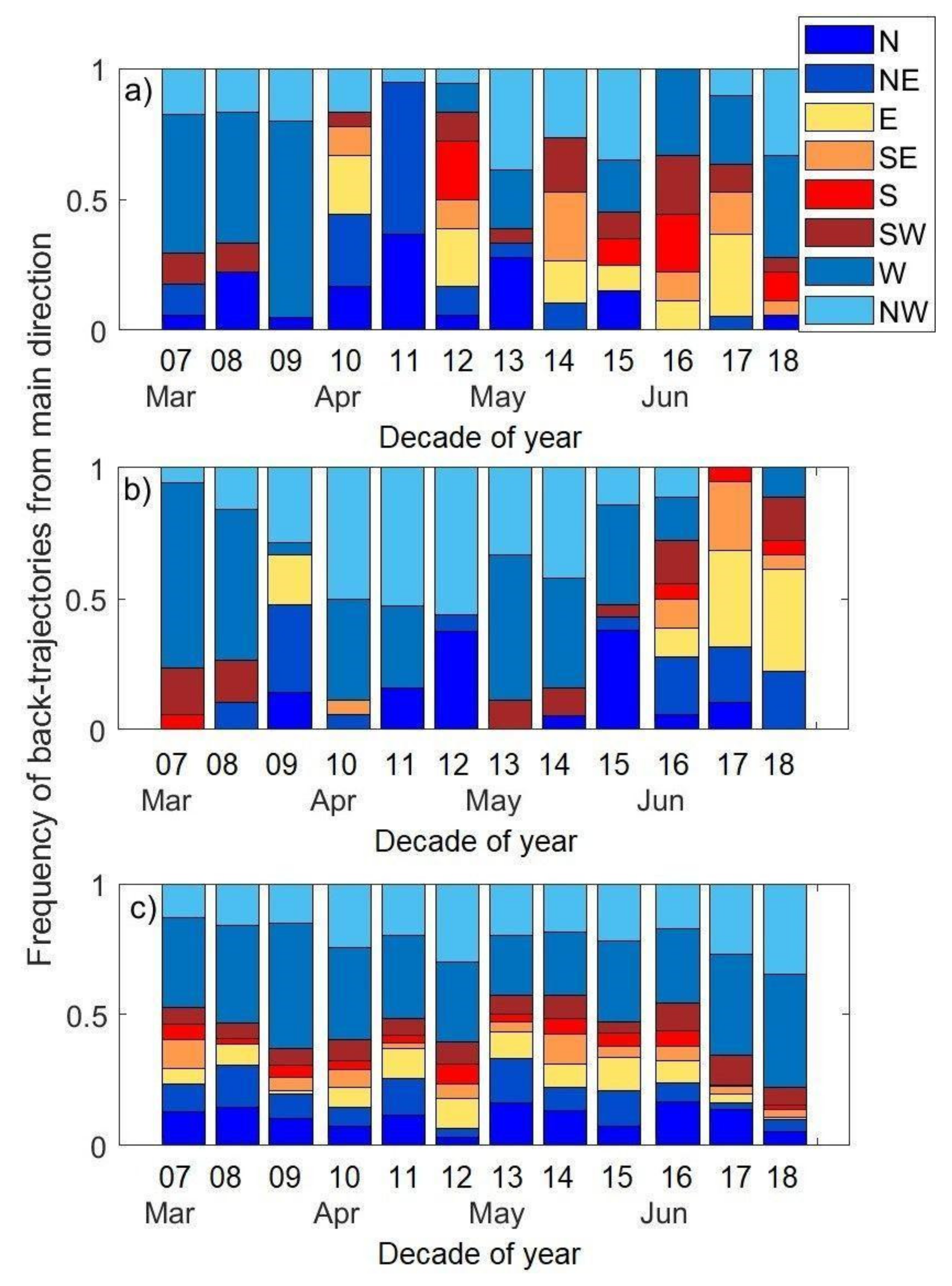
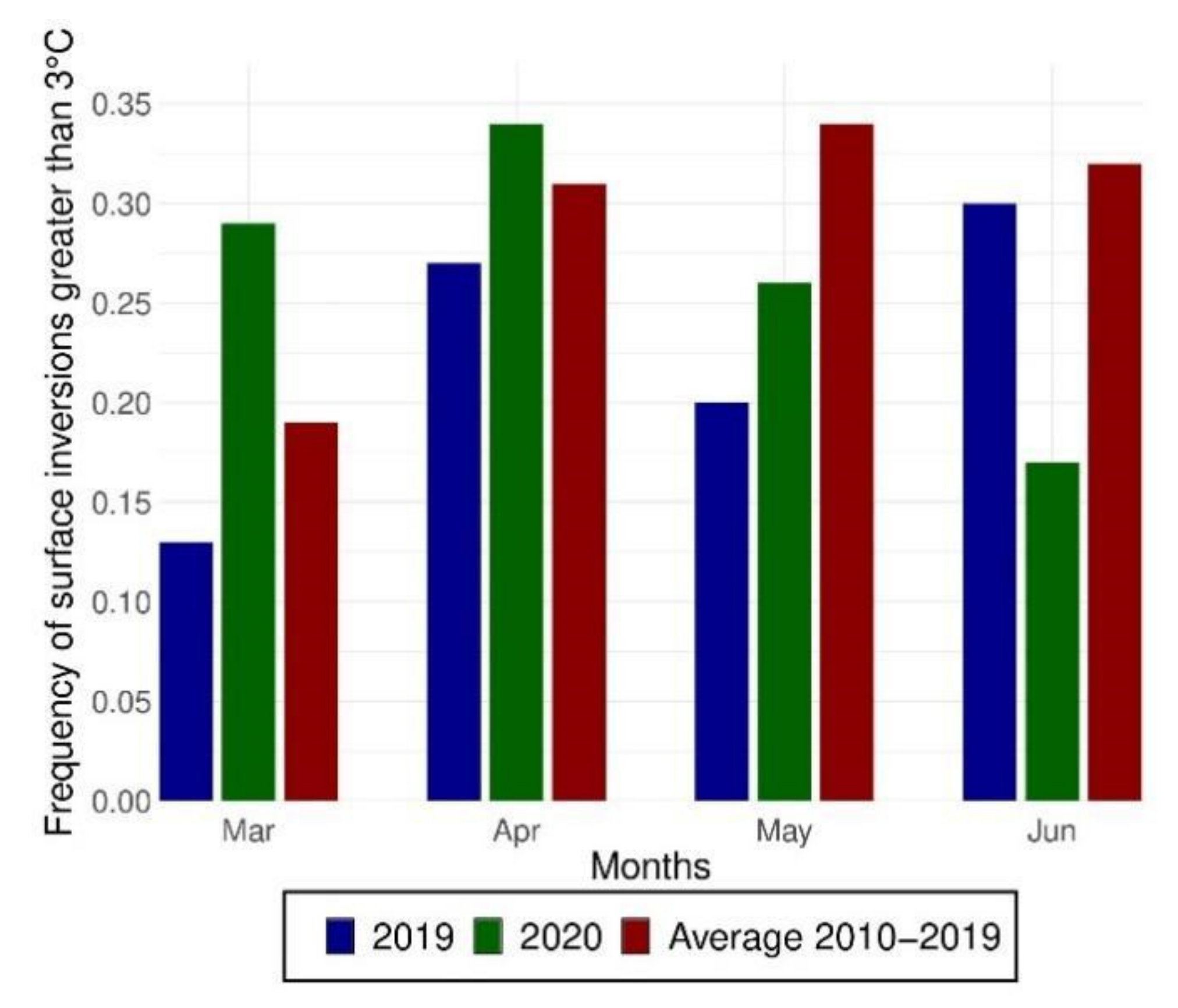
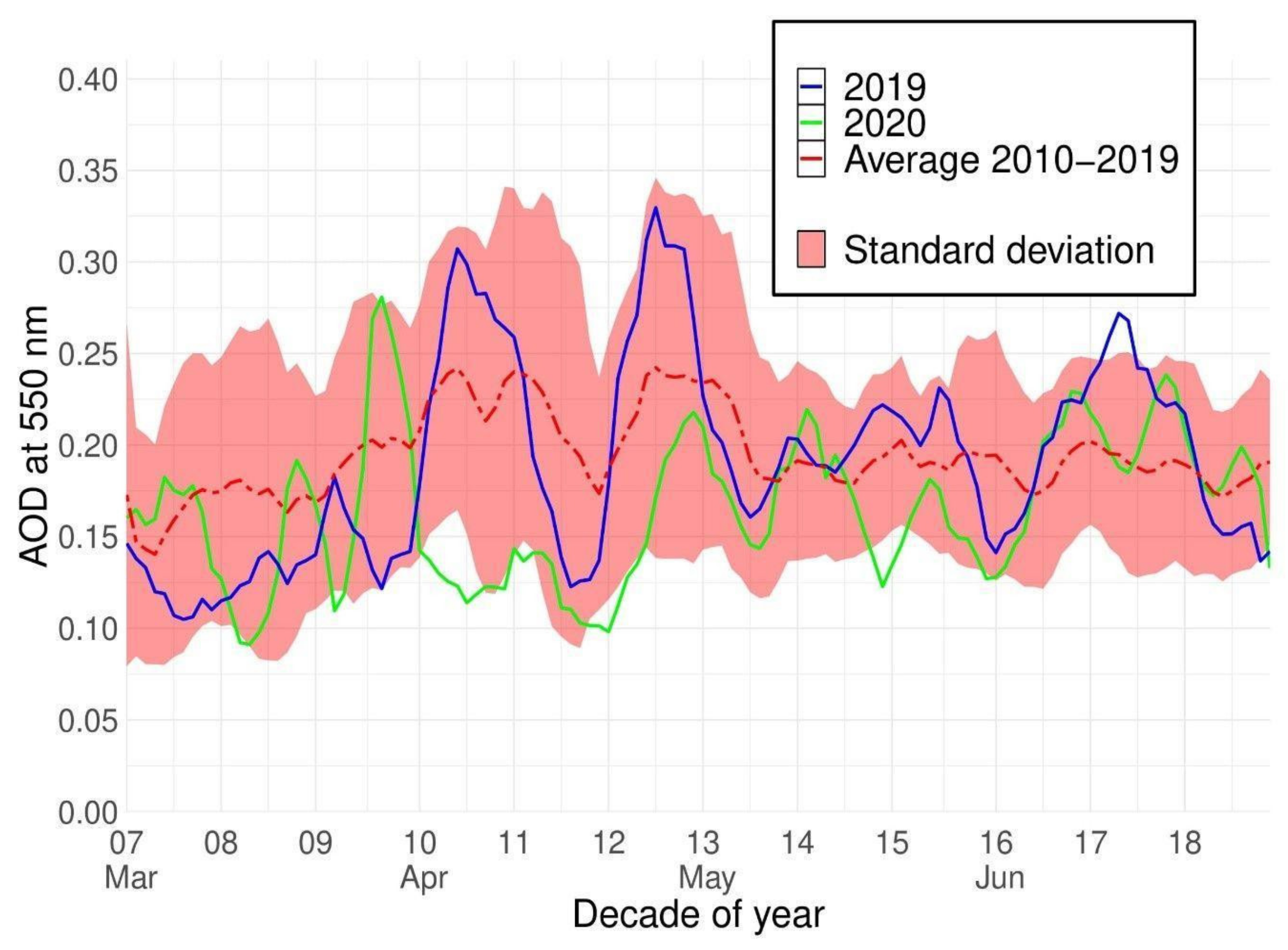
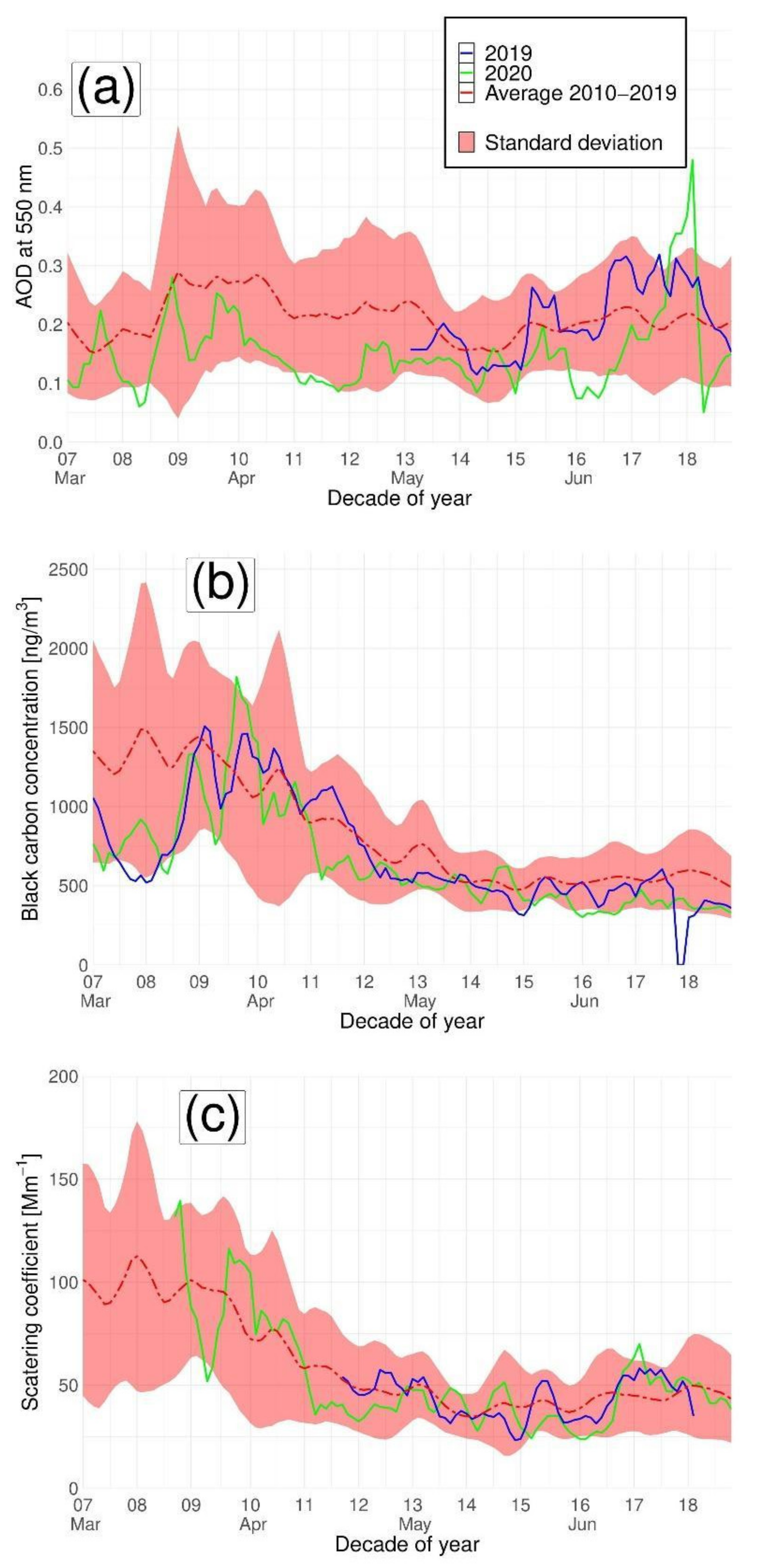
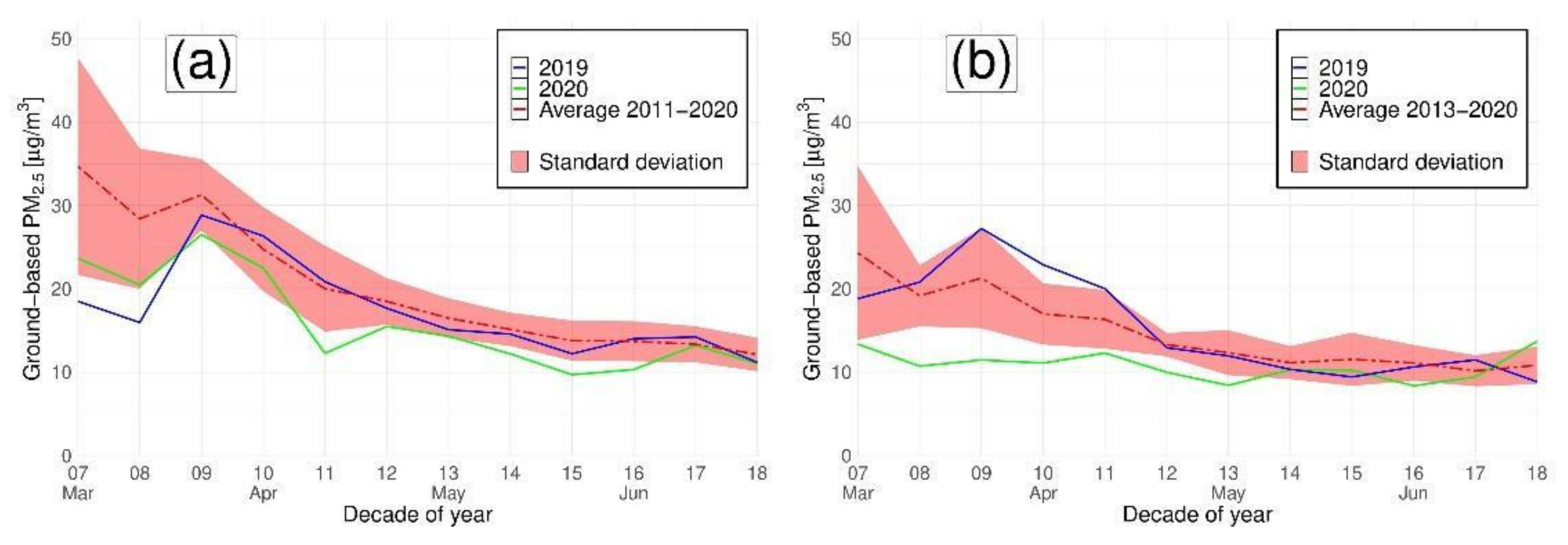

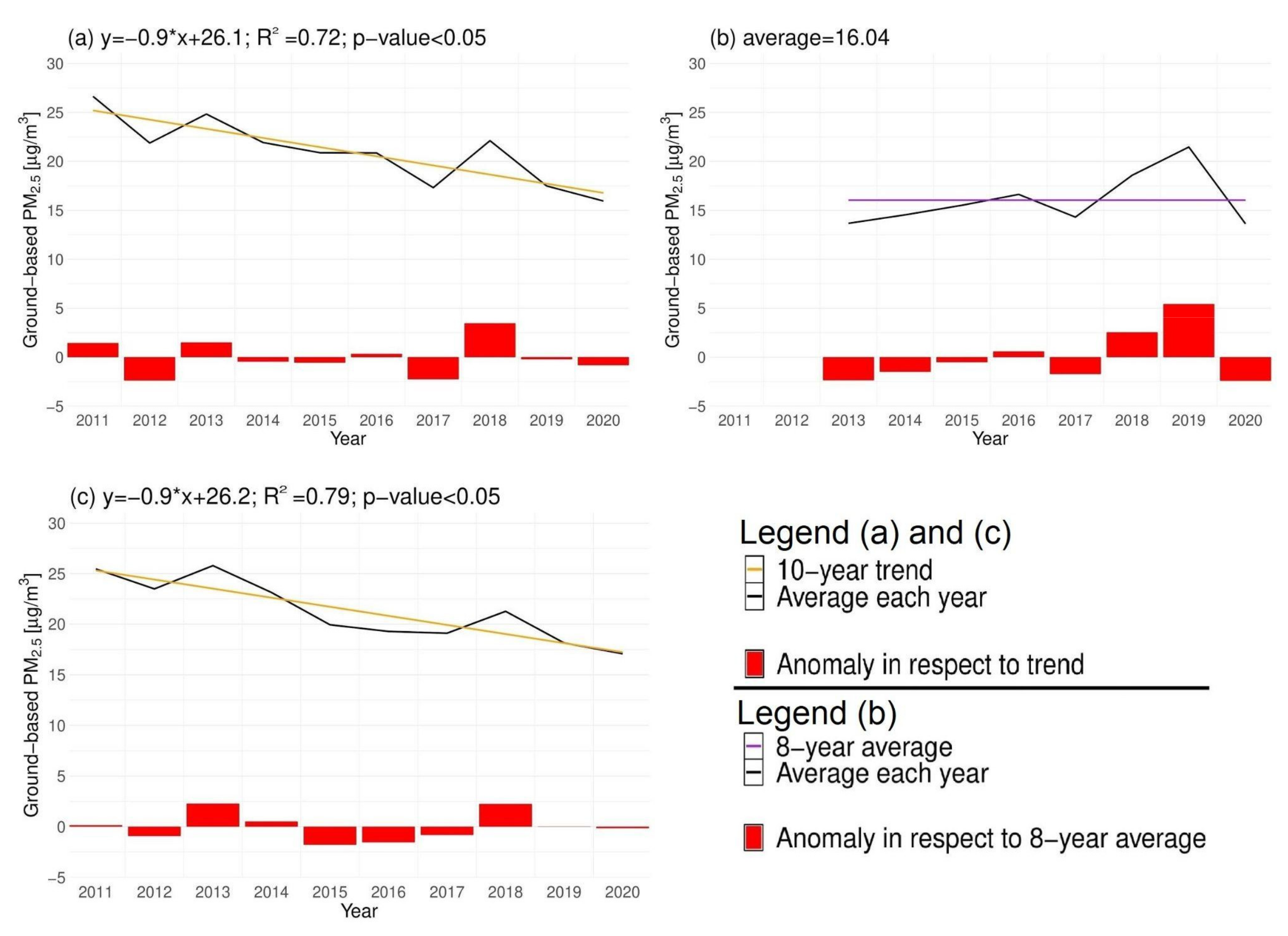

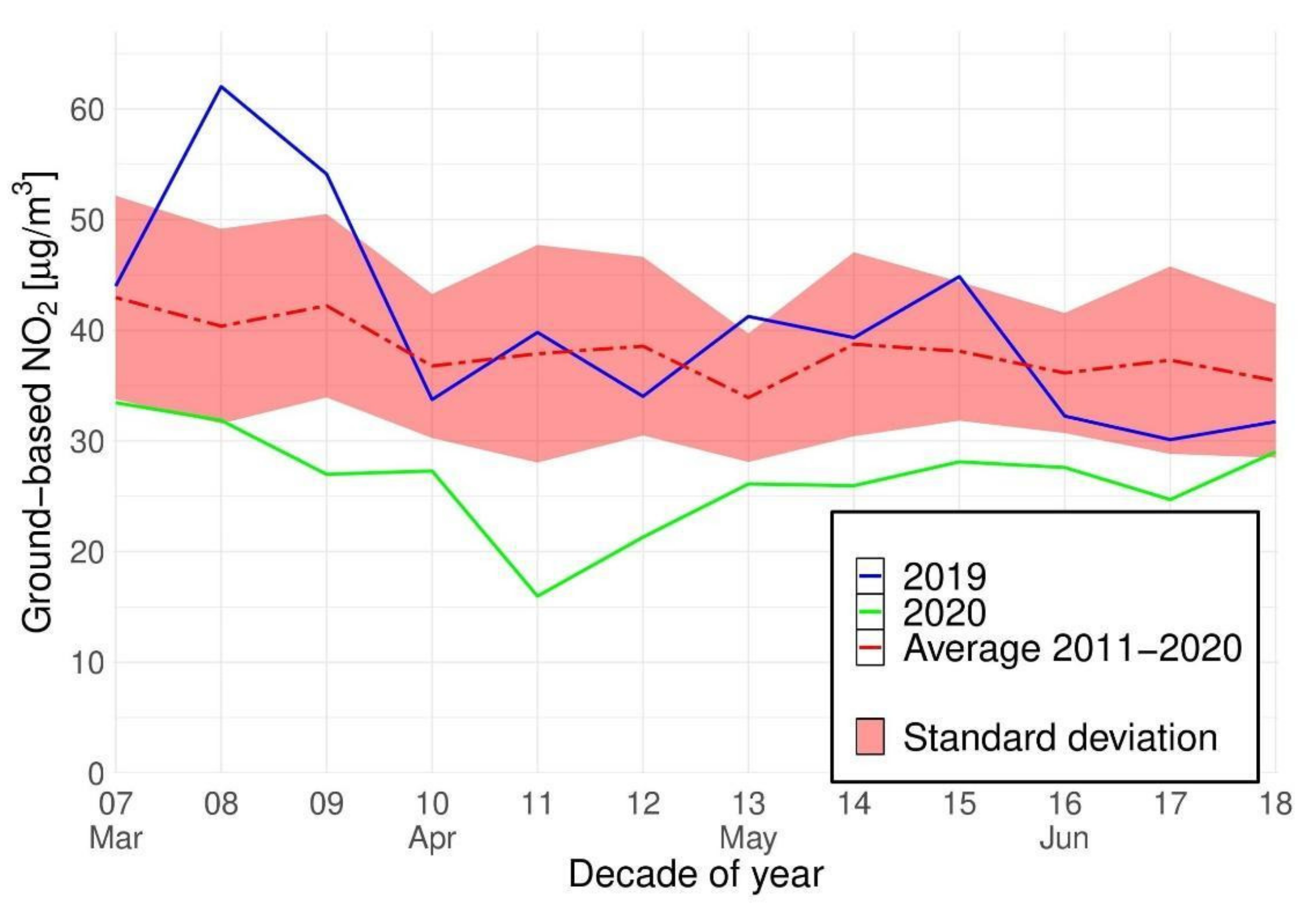
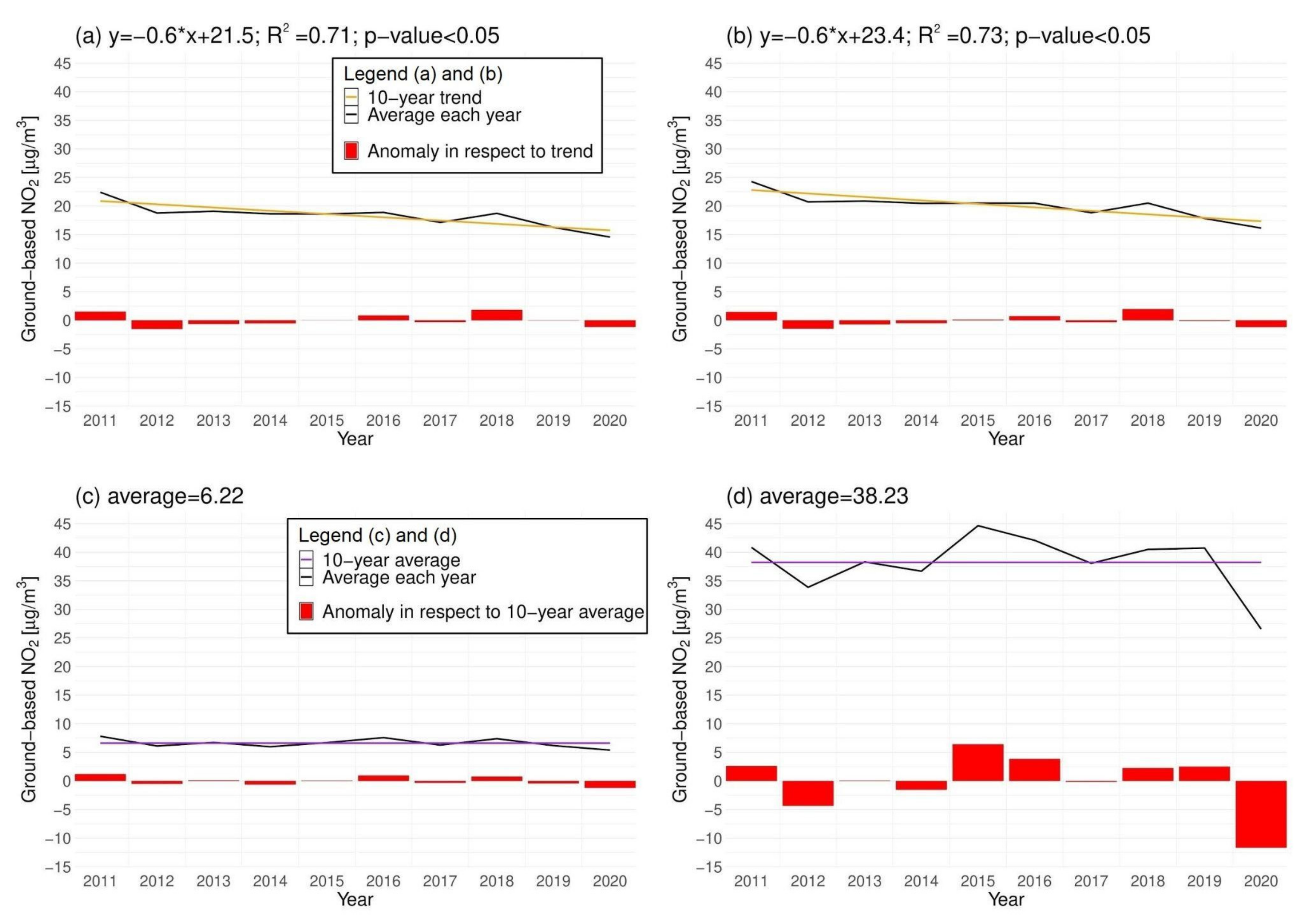
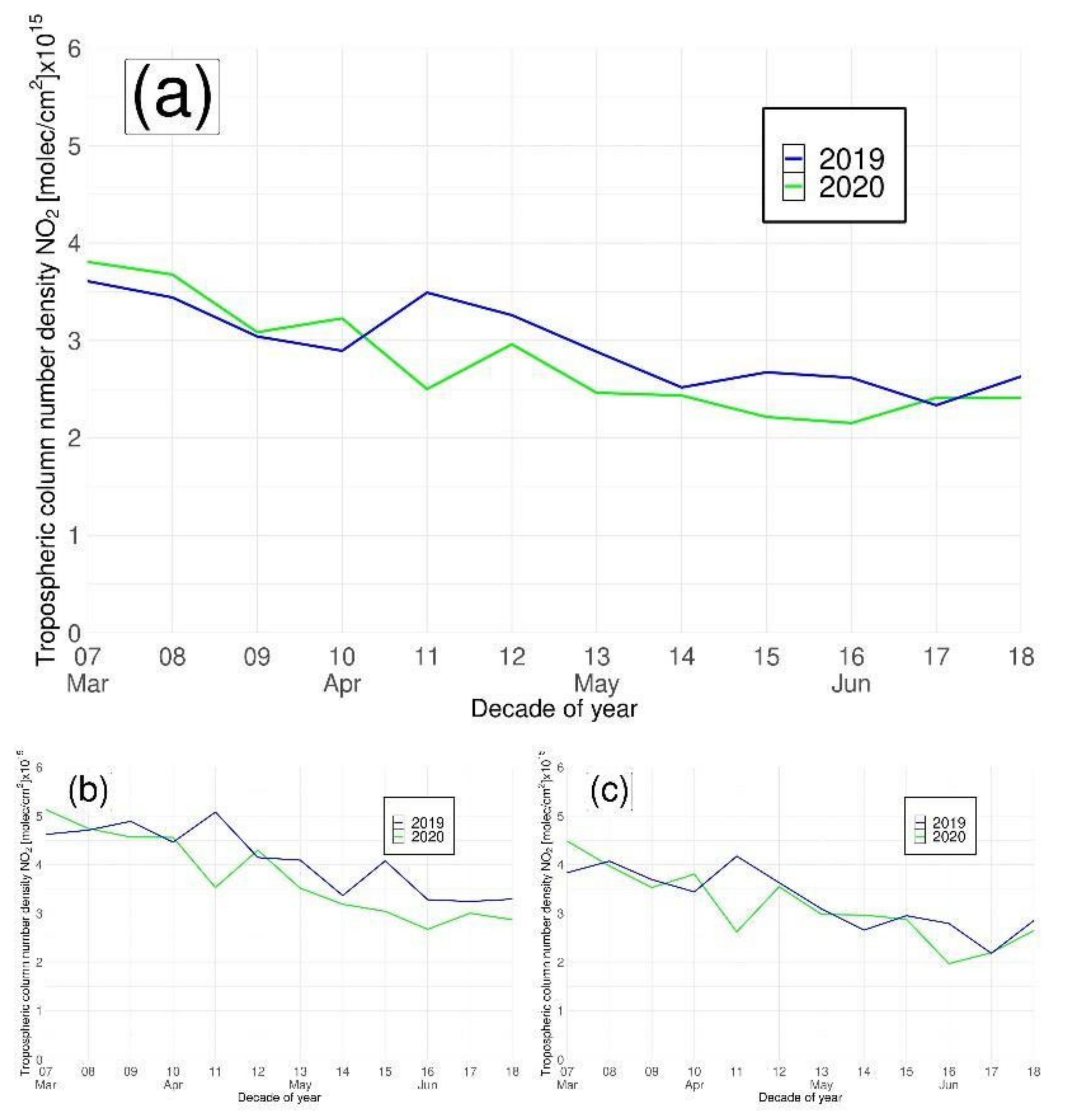
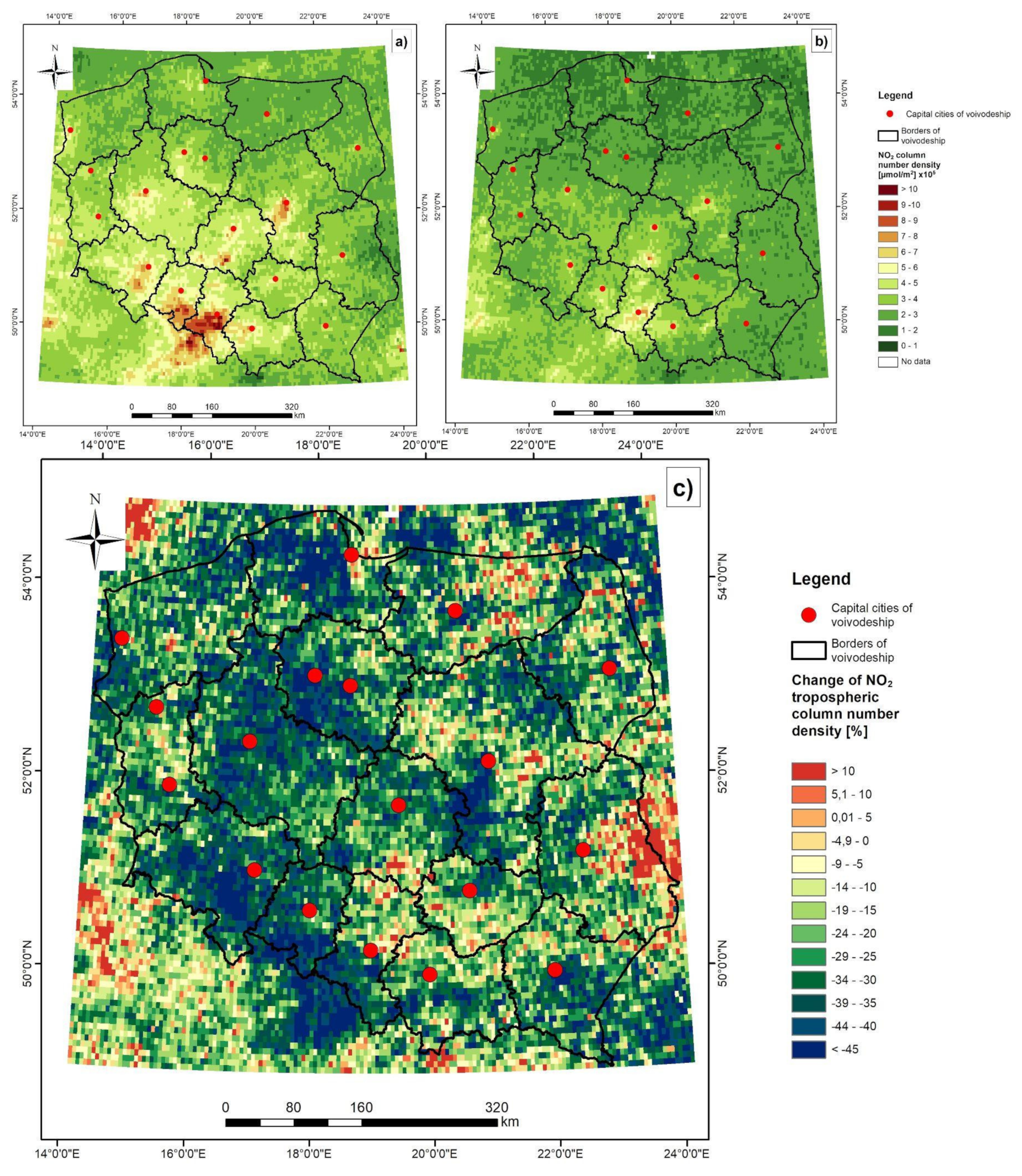

| Years | I | II | III | IV | V | VI | VII | VIII | IX | X | XI | XII | Annual |
|---|---|---|---|---|---|---|---|---|---|---|---|---|---|
| 2019 | 0.1 | 3.7 | 2.9 | 1.6 | −1.1 | 5.3 | 0.2 | 2.0 | 0.9 | 2.0 | 2.9 | 3.6 | 2.0 |
| 2020 | 4.0 | 4.8 | 1.7 | 0.5 | −2.3 | 1.9 | −0.1 | 2.0 | 1.8 | 2.0 | 2.4 | 2.4 | 1.8 |
| AOD Statistics | Sulphates | Mineral Dust | Organic Carbon | Black Carbon | Sea Salt | Total AOD |
|---|---|---|---|---|---|---|
| 2010–2019 mean | 0.111 | 0.036 | 0.028 | 0.011 | 0.008 | 0.194 |
| 2020 mean | 0.091 | 0.030 | 0.024 | 0.010 | 0.009 | 0.165 |
| 2010–2019 to 2020 relative change (%) | −18 | −16 | −15 | −8 | +18 | 15 |
Publisher’s Note: MDPI stays neutral with regard to jurisdictional claims in published maps and institutional affiliations. |
© 2021 by the authors. Licensee MDPI, Basel, Switzerland. This article is an open access article distributed under the terms and conditions of the Creative Commons Attribution (CC BY) license (https://creativecommons.org/licenses/by/4.0/).
Share and Cite
Grzybowski, P.T.; Markowicz, K.M.; Musiał, J.P. Reduction of Air Pollution in Poland in Spring 2020 during the Lockdown Caused by the COVID-19 Pandemic. Remote Sens. 2021, 13, 3784. https://doi.org/10.3390/rs13183784
Grzybowski PT, Markowicz KM, Musiał JP. Reduction of Air Pollution in Poland in Spring 2020 during the Lockdown Caused by the COVID-19 Pandemic. Remote Sensing. 2021; 13(18):3784. https://doi.org/10.3390/rs13183784
Chicago/Turabian StyleGrzybowski, Patryk Tadeusz, Krzysztof Mirosław Markowicz, and Jan Paweł Musiał. 2021. "Reduction of Air Pollution in Poland in Spring 2020 during the Lockdown Caused by the COVID-19 Pandemic" Remote Sensing 13, no. 18: 3784. https://doi.org/10.3390/rs13183784
APA StyleGrzybowski, P. T., Markowicz, K. M., & Musiał, J. P. (2021). Reduction of Air Pollution in Poland in Spring 2020 during the Lockdown Caused by the COVID-19 Pandemic. Remote Sensing, 13(18), 3784. https://doi.org/10.3390/rs13183784





